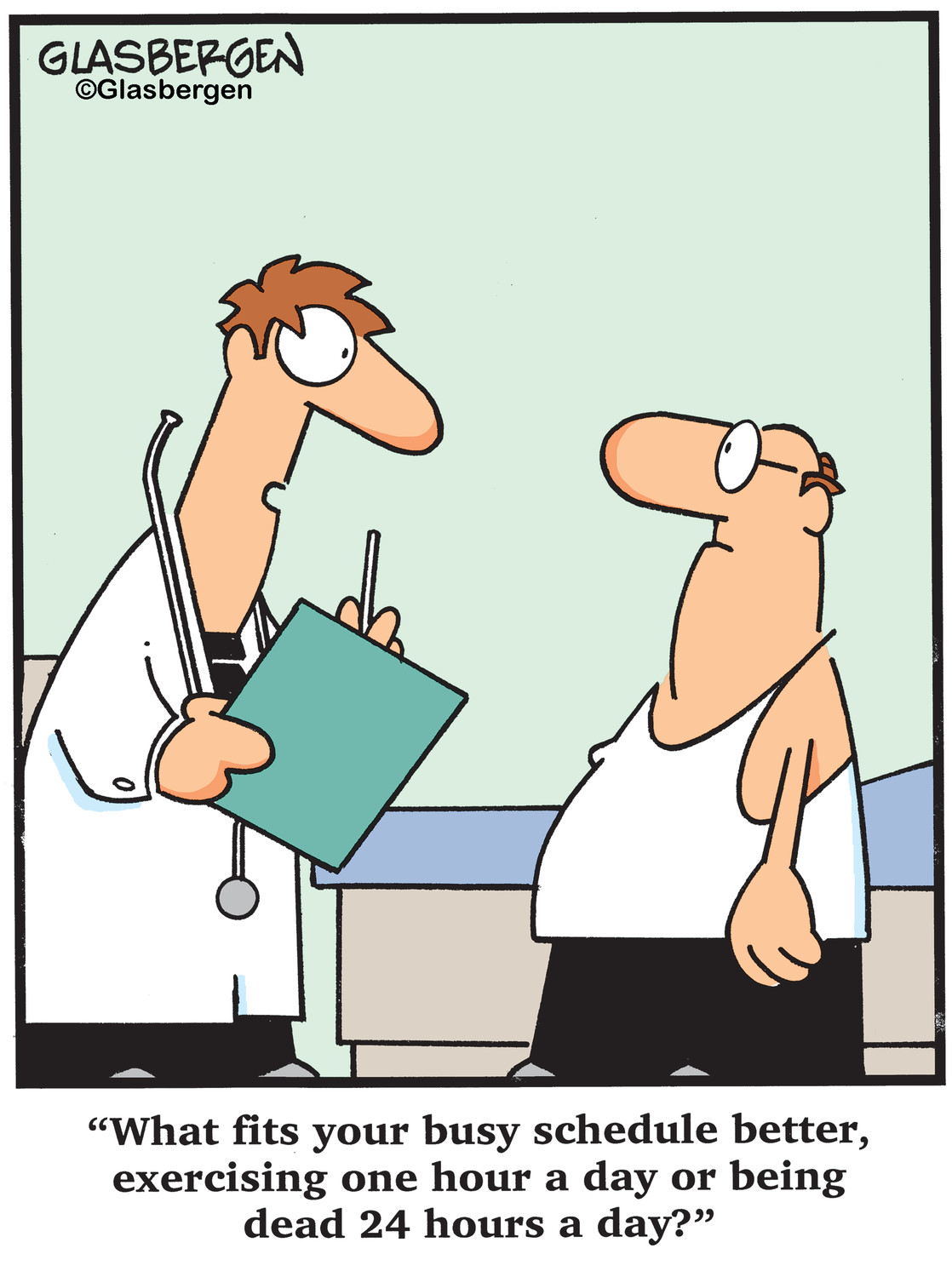There’s a place for everything – and everything in its place? Or…?
Ever get the feeling that life is preordained? That everyone, and everything, fits neatly into…
Given the plethora of research linking physical exercise with everything from improved cognitive function and creativity, protection from poor health and disease, mood regulation and general energy reserves, the committed executive (plus every man and their dog!) would be well advised to engage in some form of physical activity.
With the many competing interests that vie for our time and attention during the course of modern-day living, exercise has to get in the queue. I feel I have always been able to offer a very plausible argument for it taking number two spot, after food and drink, even over and above work and family. The following cartoon says it all for me:

However, we need to balance our body’s evolutionary requirement for probably at least ten hours of exercise of varying intensity and type every day with the need to earn a living. So, what to do? Many folk sign up with a gym. However, the vast majority succumb to the tendency of supporting the industry’s business model of making the most money from those who don’t use their services. From having heard a lifetime of reasoning that people use for not exercising, I have my suspicions as to why that is, but that might better be the subject of a separate blog. The fact is we need to find a form, or variety of forms, of exercise that give our body what it needs, in the least possible time, if we are to achieve our full physical and cognitive potential.
Our species has evolved to perform a range of ‘whole body’ movements such as running, climbing, jumping, fighting and throwing, at various levels of intensity. We are particularly suited, out of all animal species, to running, because of our two-footed, upright structure and our strategically advantageous adaptation of sweating. The fossil record shows that we originally evolved as persistence hunters. Other mammals that we have predated upon have been able to run away from us much faster than we have been able to pursue them. However, we would keep running, and running, and running. Our prey would easily sprint off to a safe distance, then stop and pant, their only way of cooling down. We would eventually catch up with them – at which point they would bolt off again. This process would continue, maybe all day over dozens of miles, until our prey collapsed through heat exhaustion. We then had a plentiful supply of protein.
From this perspective, it could be said that we are literally born to run. In evolutionary terms, we haven’t changed much since. And here’s the great thing: we don’t need to travel to a gym and faff about in changing rooms to do it. We can start as soon as we step outside the door. And running is whole body exercise, too. It engages every aspect of the body from top of head to tip of toes, and every structure in between. We can engage in it at various intensities. We can do it alone for peace and meditation or we can run with others for sociability or consolation. It’s rhythmic, so allows us to meditate in movement or allow our creative minds to wander, generating inspiration and ideas. I’ve had many a pivotal revelation while running the dog down the riverbank. Best of all, it’s free!
Now comes the avalanche of excuses I hear people using for not being ‘able’ to run. I’ve heard just about every one of them over the years. Maybe these are most efficiently dealt with in a table:
| Excuse | Response |
| I’m not built for running | Our entire species was born to run. Bang us all in Auschwitz for a couple of years and we all come out looking the same, just different heights. |
| I don’t want to damage my knees | Me neither! That’s why I run. Running strengthens your knees. Our bones, joints and soft tissues need weight-bearing activities to maintain their health. I’ve heard countless examples of people’s knees becoming symptom-free and getting stronger from running. The best way to damage your knees is to sit at a desk for 8 hours per day. In any case, why the preoccupation with knees? The forces involved in running are spread throughout the body; subject to taking the time to re-learn proper form. If you have a problem with your knees when you run, it may well be that you’ve forgotten how to run naturally or wearing those orthopaedic orthoses (how I playfully refer to the modern running shoe, along with ‘foot coffins’ or ‘foot mufflers’!) has caused the problem. |
| I can’t run because I have weak X, Y or Z (enter whatever body part you like) | Consistently strengthen it! |
| I’m a bit nervous of people watching me | Nobody’s interested in you! They’re too preoccupied with themselves to be bothered with you. Get over it! |
| Add your excuse here | Suitable response can be provided within a nano-second in 9 out of 10 cases. |
Maybe I ought to explain my lack of sympathy. Two decades in healthcare, martial arts, athletics and human performance hearing a myriad of excuses, on the one hand, and seeing countless examples of individuals with seemingly impossible circumstances turn things around on the other, has just taught me to get straight to the point. Life is too short! Why not take the advice of that age-old Nike strapline: JFDI
For guidance and advice on any of the concepts outlined in this blog, please contact me via any of the following methods:
Telephone: 01522 700600
Email: sean@refinity.co.uk
Ever get the feeling that life is preordained? That everyone, and everything, fits neatly into…
[Missing Image] Can you know the unknown? A few years ago – well, actually, about twenty years…